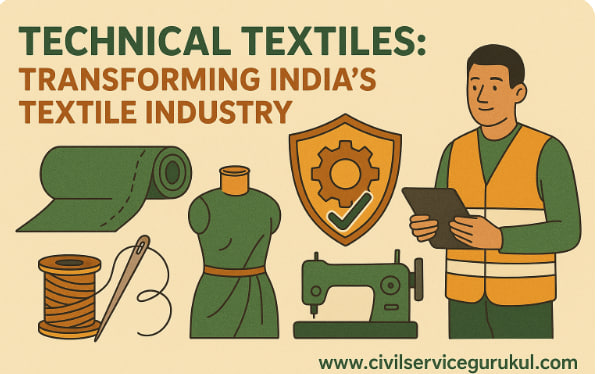Technical Textiles: Transforming India’s Textile Industry

Agriculture Extension System in India: Strengthening Rural Empowerment
June 23, 2025
Indian Railways Safety: Challenges & Reforms
June 23, 2025Technical Textiles: Transforming India’s Textile Industry
Why in News?
The National Technical Textiles Mission’s Empowered Programme Committee has approved seven startup proposals under the GREAT (Grant for Research and Entrepreneurship across Aspiring Innovators in Technical Textiles) Initiative.
Understanding Technical Textiles
Technical textiles are specialized textile materials designed for functional and technical applications, rather than aesthetic or decorative purposes. These textiles play a critical role across various industries, from agriculture, infrastructure, and healthcare to defense, space, and sports.
Applications of Technical Textiles
- Agriculture & Horticulture: Improves crop productivity using agro-textiles.
- Infrastructure: Used in geo-textiles for road construction, railway tracks, and erosion control.
- Defense & Security: Essential for bulletproof jackets, fire-resistant uniforms, and high-altitude combat gear.
- Healthcare: Meditech textiles such as surgical sutures, PPE kits, and wound-care dressings.
- Space Exploration: Heat-resistant space suits and parachutes.
Significance of Technical Textiles for India
1. Boosts Productivity & Efficiency
- According to the Technical Textiles Ecosystem in India report, the use of technical textiles in horticulture increases farm productivity by 2-5 times.
2. Convergence with Government Initiatives
- Packtech (Packaging Textiles) can aid in phasing out single-use plastics by providing sustainable alternatives.
- India dominates the Packtech market, holding a 40-45% global share.
3. High Growth Potential
- The Indian technical textiles market is growing at a rate of 8-10% annually.
- It is the fifth largest in the world, valued at USD 21.95 billion (2021-22).
4. Rising Export Opportunities
- India’s technical textiles exports surged from USD 2.21 billion (2020-21) to USD 2.85 billion (2021-22), registering 28.4% growth.
5. Employment & Entrepreneurial Growth
- High-value industry generating skilled jobs and attracting investments.
- Potential to increase MSME participation and startup ecosystem.
Challenges Hindering Growth of Technical Textiles in India
1. Heavy Dependence on Imports
- Most of the machinery required for producing technical textiles is imported, increasing production costs.
2. Limited Awareness & Adoption
- Many end-users, including farmers and industries, are unaware of the benefits and applications of technical textiles.
3. Lack of Standardization & Quality Control
- Absence of well-defined standards leads to the availability of sub-standard products, affecting market trust.
- Institutional buyers (like defense) prefer imports due to higher quality standards.
4. Entrepreneurial & R&D Deficiency
- Limited entrepreneurship culture and inadequate research & development (R&D) facilities hinder innovation.
- Inconsistent investments in R&D restrict advancements in product development.
Government Initiatives to Promote Technical Textiles
1. National Technical Textiles Mission (NTTM)
- Launched by: Ministry of Textiles
- Implementation Period: 2020-21 to 2023-24
- Objective: Position India as a global leader in technical textiles.
2. GREAT Initiative (Grant for Research and Entrepreneurship Across Aspiring Innovators in Technical Textiles)
- Launched by: Ministry of Textiles.
- Aim: Encourages young scientists, technologists, and entrepreneurs to innovate in technical textiles.
- Financial Support: Provides up to ₹50 lakh in grant-in-aid for 18 months.
3. Production Linked Incentive (PLI) Scheme for Textiles
- Objective: Boosts domestic production and exports of man-made fibers and technical textiles.
4. PM MITRA Scheme (Mega Integrated Textile Regions and Apparel Parks)
- Aims to develop world-class textile infrastructure and increase industry competitiveness.
5. Quality Control Regulations & Standardization
- BIS Standards: Over 500 BIS standards developed for technical textiles.
- Quality Control Orders (QCOs) issued for:
- Geo-tech textiles (19 items)
- Protective textiles (12 items)
- Agro-tech textiles (20 items)
- Meditech textiles (6 items)
6. Mandatory Use of Technical Textiles
- Several ministries & departments have mandated technical textiles use in infrastructure, defense, and agriculture.
Way Forward: Strengthening India’s Technical Textiles Sector
1. Awareness & Training
- Public-private collaborations should launch awareness campaigns to educate industries and farmers.
- Incorporate technical textiles into skill development programs.
2. Boost R&D & Innovation
- Set up PPP-model ‘Centers of Excellence’ to support research, market linkages, and capacity-building.
- Encourage startups through incubation centers and grants.
3. Technology Transfer & Joint Ventures
- Encourage foreign collaborations to facilitate technology transfer and reduce dependency on imports.
4. Standardization & Certification
- Strengthen quality control regulations to promote global acceptance of Indian technical textiles.
5. Strengthening Export Potential
- Develop India-specific brands in global technical textiles markets.
- Leverage free trade agreements (FTAs) to boost exports.
Multiple Choice Questions (MCQs)
1. What is the primary purpose of technical textiles?
(a) Enhancing the aesthetic appeal of fabrics.
(b) Improving fashion trends in the textile industry.
(c) Providing functional and technical applications across various industries.
(d) Reducing textile waste in the environment.
Answer: (c) Providing functional and technical applications across various industries.
2. Which of the following initiatives aims to encourage research and entrepreneurship in technical textiles?
(a) PM MITRA Scheme
(b) PLI Scheme for Textiles
(c) National Technical Textiles Mission
(d) GREAT Initiative
Answer: (d) GREAT Initiative

